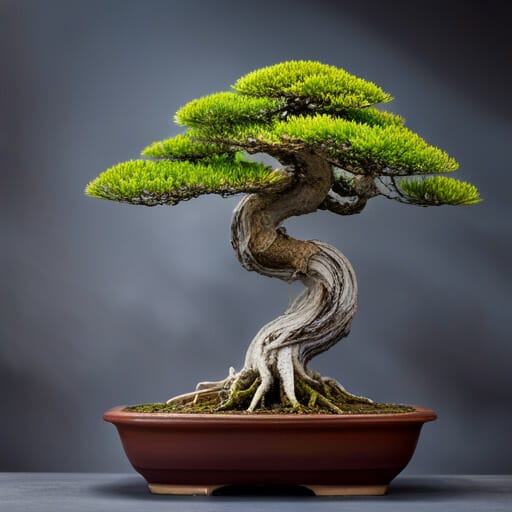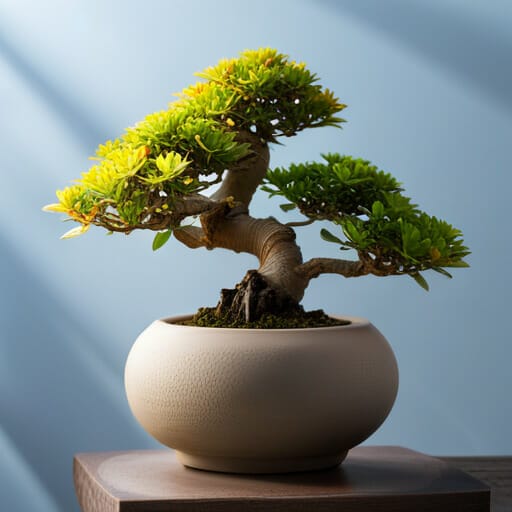Bonsai, the art of cultivating miniature landscapes, requires careful attention to detail and the use of specialized tools and techniques. One essential tool in the practice of bonsai is the training pot, which plays a crucial role in nurturing the growth and development of these artful creations.
Imagine a small, vibrant bonsai tree flourishing within a shallow, porous pot, carefully designed to mimic the natural landscape it represents. This miniature masterpiece is the result of years, even decades, of patient training and cultivation.
In this article, we will explore the benefits of using training pots in bonsai cultivation, the characteristics that make an ideal pot, and the different materials available for these pots.
We will delve into the importance of shallow depth, good drainage and air circulation, as well as water retention in the pot. Additionally, we will discuss the suitability of various materials such as clay, porcelain, and stoneware for bonsai training.
By understanding the significance of training pots and selecting the right one for your bonsai, you can effectively nurture and maintain these artful miniature landscapes, creating stunning displays that bring joy and serenity to both the creator and those who behold them.
Contents
- 1 Quick Points
- 2 Benefits of Training Pots
- 3 Ideal Pot Characteristics
- 4 Choosing the Right Material
- 5 Frequently Asked Questions
- 5.1 Can any type of pot be used for bonsai training?
- 5.2 How long does it typically take for a bonsai tree to become fully trained?
- 5.3 Are there any specific techniques for designing a bonsai tree to reflect a natural landscape?
- 5.4 Are there any alternative materials to clay pots that can be used for bonsai training?
- 5.5 Can plastic training pots be used temporarily during the early stages of bonsai training?
Quick Points
- Bonsai training pots are essential tools in bonsai cultivation and are designed to mimic natural landscapes.
- Training pots offer benefits such as adapting the root system to a small volume, restricting root growth, and promoting a compact and well-balanced root system.
- Clay pots are recommended for bonsai cultivation due to their advantageous characteristics like good aeration, drainage, heat absorption, and dissipation ability.
– Porcelain pots and plastic pots are not suitable for bonsai training due to poor airflow and drainage.
Benefits of Training Pots

The use of bonsai training pots offers several benefits, including the ability to adapt the root system to a small rooting volume, which is essential for nurturing and shaping the tree into an artful miniature landscape.
These pots provide the necessary conditions for the tree to thrive and develop its unique characteristics. The shallow depth of the pots restricts the growth of the roots, encouraging them to spread horizontally rather than vertically. This promotes a compact and well-balanced root system, which is crucial for maintaining the tree’s health and stability.
Moreover, the porous material of the training pots allows for good drainage and air circulation, preventing the roots from becoming waterlogged and suffocated. Additionally, the pots’ ability to retain water ensures that the tree receives adequate hydration without the risk of overwatering.
Overall, bonsai training pots are an integral tool for cultivating and nurturing these captivating miniature landscapes.
Learn About The Ideal Time To Train Your Pot
Ideal Pot Characteristics

Clay pots, with their advantageous characteristics of good aeration, drainage, heat absorption and dissipation ability, are highly recommended for cultivating bonsai trees.
These pots provide the ideal environment for the growth and development of bonsai trees. The shallow depth of clay pots allows for the control and restriction of the root system, promoting the development of a compact root ball.
The porous nature of clay pots ensures proper airflow and water drainage, preventing waterlogged roots and promoting healthy root growth. Additionally, clay pots have the ability to absorb and dissipate excess heat, preventing overheating of the roots during hot weather.
Overall, the use of clay pots in bonsai training ensures the optimal conditions for the successful cultivation of artful miniature landscapes.
Choosing the Right Material

When selecting the material for bonsai training pots, it is important to consider the specific requirements for optimal root growth and development. Bonsai training pots should provide the necessary conditions for the tree to thrive and become a miniature landscape.
The ideal material for bonsai training pots is clay. Clay pots offer several advantages such as good aeration, drainage, water retention, and heat absorption and dissipation ability. These characteristics promote healthy root growth, allowing the tree to establish a strong foundation.
In contrast, porcelain pots are not suitable for bonsai training as they have poor airflow and drainage. Plastic pots are also not recommended as they do not allow proper air and water circulation. Stoneware pots can be used in later stages of training as they are slightly porous and offer some aeration and water absorption ability.
Choosing the right material for bonsai training pots is crucial in nurturing artful miniature landscapes and serving the needs of the bonsai tree.
Frequently Asked Questions
Can any type of pot be used for bonsai training?
No, not any type of pot can be used for bonsai training. Clay pots are the best choice due to their ability to provide good drainage, aeration, and water retention, while plastic pots hinder bonsai growth.
How long does it typically take for a bonsai tree to become fully trained?
The time it takes for a bonsai tree to become fully trained varies and can range from years to decades. This process involves designing the tree to reflect a natural landscape and requires patience and dedication.
Are there any specific techniques for designing a bonsai tree to reflect a natural landscape?
Designing a bonsai tree to reflect a natural landscape involves techniques such as selecting a suitable tree species, shaping and pruning branches, creating a sense of scale and proportion, replicating natural features like mountains and valleys, and using appropriate accessories and accent plants.
Are there any alternative materials to clay pots that can be used for bonsai training?
Alternative materials to clay pots for bonsai training include stoneware pots, which offer some aeration and water absorption ability, and plastic pots, although they do not allow for proper air and water circulation.
Can plastic training pots be used temporarily during the early stages of bonsai training?
Plastic training pots are not suitable for bonsai growth, as they do not allow air and water to pass through. Therefore, they should not be used temporarily or at any stage of bonsai training.



